1686ss08
1686ss08.docx
NESHAP for the Secondary Lead Smelter Industry (40 CFR part 63, subpart X) (Proposed Rule)
OMB: 2060-0296
SUPPORTING STATEMENT
NATIONAL EMISSION STANDARDS FOR SECONDARY LEAD SMELTING
PART A
1.0 Identification of the Information Collection
(a) Title and Number of the Information Collection.
“National Emission Standards for Hazardous Air Pollutants (NESHAP) for Secondary Lead Smelting (40 CFR part 63, subpart X), EPA ICR number 1686.08, OMB Control Number 2060-0296.
(b) Short Characterization.
This ICR is prepared for a U.S. Environmental Protection Agency (EPA) rulemaking developed under authority of section 112 of the Clean Air Act (CAA). The rulemaking amends title 40, chapter I, part 63, subpart X, National Emission Standards for Hazardous Air Pollutants (NESHAP) for Secondary Lead Smelting, of the Code of Federal Regulations (CFR). The current NESHAP were proposed on June 23, 1995, and promulgated on June 13, 1997. The potential respondents are owners or operators of any existing or new affected source with secondary lead smelting operations. There are 14 facilities subject to the NESHAP. The NESHAP is applicable to the following processes at a secondary lead smelter: blast, reverberatory, rotary, and electric smelting furnaces; refining kettles; agglomerating furnaces; dryers; process fugitive sources; and fugitive dust sources. The affected sources are those that meet the criteria established in §63.541 of the Secondary Lead Smelting NESHAP.
The proposed amendments would reduce the emissions limits for lead. Specifically, sources would be required to maintain the concentration of lead compounds in any process vent gas at or below 1.0 milligrams of lead per dry standard cubic meter (0.00043 grains of lead per dry standard cubic foot), and they would also be required to maintain the flow-weighted average concentration of lead compounds in vent gases from a secondary lead facility at or below 0.20 milligrams of lead per dry standard cubic meter (0.000087 grains of lead per dry standard cubic foot). The proposed amendments would also establish emissions limits for total hydrocarbons (THC) and dioxins and furans (D/F) from furnace sources, as follows.
The proposed amendments include an emissions limit for THC of 12 ppmv (expressed as propane) corrected to 4 percent CO2 for new and existing reverberatory furnaces not collocated with a blast furnace and reverberatory furnaces mixed with electric furnaces. The proposed amendments also include a THC limit for new and existing rotary furnaces of 610 ppmv (expressed as propane and adjusted to 4 percent CO2).
With regard to dioxins and furans, we are proposing to revise the 1997 NESHAP to include the following emissions limits for dioxins and furans:
For reverberatory furnaces not collocated with blast furnaces and reverberatory furnaces where the exhaust gases are mixed with electric furnaces, a limit of 0.20 ng/dscm at 7 percent O2 and 0.1 ng/dscm at 7 percent O2 for existing and new affected sources, respectively.
For blast furnaces, a limit of 170 ng/dscm at 7 percent O2 and 10 ng/dscm at 7 percent O2 for existing and new sources, respectively.
For collocated blast and reverberatory furnaces, a limit of 0.5 ng/dscm at 7 percent O2 for both new and existing sources.
For rotary furnaces, a limit of 1.0 ng/dscm at 7 percent O2 for both new and existing sources.
To control fugitive lead emissions, under the proposed amendments, we are proposing that each facility must totally enclose all sources of fugitive emissions (e.g., storage piles, material handling, battery breaking, dryers, and casting kettles) and operate the total enclosure under negative pressure and implement comprehensive work practices, including pavement cleaning and vehicle washing, cleaning of building rooftops on a regular (e.g., at least once per month) schedule, cleaning of all affected areas after accidental releases, inspection of the battery storage areas for broken batteries, performance of maintenance activities inside enclosures, and transport of lead bearing material in closed systems. Or, as an alternative, we are proposing that facilities can conduct ambient monitoring for lead compounds at the property boundary based on a monitoring plan approved by the Administrator that includes a minimum of two monitors including one located at a site expected to have the highest lead air concentrations. The requirements for full enclosure and the option for the ambient monitoring and the development of a monitoring plan would be new provisions under the proposed amendments.
The amendments to the rule eliminate the startup, shutdown, and malfunction exemption, remove the SSM plan requirement, add provisions to provide an affirmative defense against civil penalties for exceedances of emission standards caused by malfunctions, and a requirement for electronic submittal of performance test data, and correct editorial errors.
Recordkeeping for stack testing will be the same with the exception of frequency. Recordkeeping for the ambient lead monitoring option would include maintaining the 3-month rolling average documented on a monthly basis and reported quarterly.
All of the proposed amendments have a compliance date of 3 years from the promulgation date which will allow the facility to implement any changes necessary to meet the new and revised requirements. The proposed amendments require stack testing for lead compounds and THC on an annual basis, and every 5 years for dioxins/furans. The remaining portions of the NESHAP remain unchanged.
The information collection requirements associated with the proposed amendments to the NESHAP are listed in Attachment 2.
2. Need For and Use of the Collection
(a) Need/Authority for the Collection.
Section 112 of the Clean Air Act (CAA) requires EPA to establish NESHAP for both major and area sources of HAP that are listed for regulation under CAA section 112(c). A major source is a stationary source that emits or has the potential to emit more than 10 tons per year (tpy) of any single HAP or more than 25 tpy of any combination of HAP. An area source is a stationary source that is not a major source (i.e., an area source does not emit and does not have the potential to emit more than 10 tpy of any single HAP and more than 25 tpy of any combination of HAP). For major sources, these technology-based standards must reflect the maximum degree of emission reductions of HAP achievable (after considering cost, energy requirements, and non-air quality health and environmental impacts) and are commonly referred to as maximum achievable control technology (MACT) standards. Section 112(d)(6) requires EPA to review these technology-based standards and to revise them “as necessary (taking into account developments in practices, processes, and control technologies)” no less frequently than every 8 years. In addition, section 112(f) of the CAA requires EPA to determine for source categories subject to certain CAA section 112(d) standards whether the emissions limitations provide an ample margin of safety to protect public health. For MACT standards for HAP “classified as a known, probable, or possible human carcinogen" that "do not reduce lifetime excess cancer risks to the individual most exposed to emissions from a source in the category or subcategory to less than 1-in-1 million,” EPA must promulgate residual risk standards for the source category (or subcategory) as necessary to provide an ample margin of safety to protect public health. In doing so, EPA may adopt standards equal to existing MACT standards, if EPA determines that the existing standards are sufficiently protective. EPA must also adopt more stringent standards, if necessary, to prevent an adverse environmental effect, but must consider cost, energy, safety, and other relevant factors in doing so.
Certain records and reports are necessary for the Administrator to confirm the compliance status of sources subject to NESHAP, identify any new or reconstructed sources subject to the standards, and confirm that the standards are being achieved on a continuous basis. These recordkeeping and reporting requirements are specifically authorized by section 114 of the Clean Air Act (42 U.S.C. 7414) and set out in the part 63 NESHAP General Provisions. The recordkeeping and reporting requirements for title V permits are contained in 40 CFR 70.6 and 40 CFR 71.6. Under parts 63 and 70 or 71, the owner or operator must keep each record for 5 years following the date of each occurrence, measurement, maintenance, corrective action, report, or record.
(b) Use/Users of the Data.
The information will be used by the delegated authority (State agency, or Regional Administrator if there is no delegated State agency) to ensure that the standards and other requirements are being achieved. Based on review of the recorded information at the site and the reported information, the delegated permitting authority can identify facilities that may not be in compliance and decide which facilities, records, or processes may need inspection.
3. Nonduplication, Consultations, and Other Collection Criteria
(a) Nonduplication.
A computer search of EPA’s ongoing ICRs revealed no duplication of information-gathering efforts.
(b) Public Notice Required Prior to ICR Submission to OMB.
The preamble to the proposed rule will provide public notice of this ICR.
(c) Consultations.
The proposed amendments were developed in consultation with the Association of Battery Recyclers (ABR) and various companies (including RSR Corporation and Exide Corporation, who own 9 of the 14 facilities). The non-EPA persons consulted on the information collection activities are identified in Table 1.
TABLE 1. PERSONS CONSULTED ON THE INFORMATION COLLECTION ACTIVITIES
Contact |
Organization |
Telephone No. |
Russell Kemp |
Environ Corp. |
678-388-1654 |
Robert Steinwurtzel |
Baker and Hostetler |
202-861-1708 |
Steve Arnold |
The Doe Run Company |
573-626-3495 |
Mark Cummings |
Exide Corp. |
678-566-9280 |
Mike Butkantz |
RSR Corp |
626-937-3245 |
(d) Effects of Less Frequent Collection.
If the relevant information was collected less frequently, the delegated permitting authority (State or EPA) will not be reasonably assured that a facility is in compliance with the standards.
(e) General Guidelines.
None of the guidelines in 5 CFR 1320.6 are being exceeded.
(f) Confidentiality.
All information submitted to the Agency for which a claim of confidentiality is made will be safeguarded according to the Agency policies set forth in Title 40, Chapter 1, Part 2, Subpart B--Confidentiality of Business Information (see 40 CFR 2; 41 FR 36902, September 1, 1976; amended by 43 FR 39999, September 28, 1978; 43 FR 42251, September 28, 1978; 44 FR 17674, March 23, 1979).
(g) Sensitive Questions.
This section is not applicable because this ICR does not involve matters of a sensitive nature.
4. The Respondents and the Information Requested
(a) Respondents/NAICS Codes.
Potential respondents under subpart X are owners or operators of any existing or new facility engaged in secondary lead smelting. Secondary lead smelting facilities are primarily classified under NAICS codes 331492, Secondary Lead Smelting and Refining.
There are 14 facilities that will be subject to the proposed amendments to the NESHAP. No new secondary lead facilities are expected during the 3year period of this ICR.
(b) Information Requested.
(i) Data Items, Including Recordkeeping Requirements. Attachment 2, Information Requirements, summarizes the data items, including recordkeeping and reporting requirements, for the Secondary Lead Smelting source category. The amendments to the NESHAP require that any performance tests performed after December 31, 2011 be submitted electronically to EPA’s Central Data Exchange by using the Electronic Reporting Tool (ERT) for test methods that are compatible with ERT. This new requirement to submit the data to the ERT is in addition to the other existing submission requirements for this data.
(ii) Respondent Activities. The respondent activities that will be required by the proposed amendments to the Secondary Lead Smelting NESHAP are identified in Tables 1-3 of Attachment 1 and are introduced in section 6(a).
EPA is including an estimate of the burden associated with performing an affirmative defense. EPA is providing this as an illustrative example of the potential additional administrative burden a source may incur to assert in an Affirmative Defense in response to an action to enforce the standards set forth in the applicable subpart.
This illustrative estimate is not considered a duplicate estimate of cost under the General Duty to Minimize Emissions clause under 63.6(e)(1)(i), which states: “At all times, the owner and operator must operate and maintain any affected source, including associated air pollution control equipment and monitoring equipment, in a manner consistent with safety and good air pollution control practices for minimizing emissions. Determining whether such operation and maintenance procedures are being used will be based on information available to the Administrator which may include, but is not limited to, monitoring results, review of operation and maintenance procedures, review of operation and maintenance records, and inspection of the source.”
To provide the public with an estimate of the relative magnitude of the burden associated with an assertion of the affirmative defense position adopted by a source, EPA provides an administrative adjustment to this ICR that estimates the costs of the notification, recordkeeping and reporting requirements associated with the assertion of the affirmative defense. EPA’s estimate for the required notification, reports and records, including the root cause analysis, associated with a single incident totals approximately $3,141 and is based on the time and effort required of a source to review relevant data, interview plant employees, and document the events surrounding a malfunction that has caused an exceedance of an emission limit. The estimate also includes time to produce and retain the records and reports for submission to EPA. EPA provides this illustrative estimate of this burden because these costs are only incurred if there has been a violation and a source chooses to take advantage of the affirmative defense.
Of the number of excess emission events reported by source operators, only a small number would be expected to result from a malfunction, and only a subset of excess emissions caused by malfunctions would result in the source choosing to assert the affirmative defense. Thus we believe the number of instances in which source operators might be expected to avail themselves of the affirmative defense will be extremely small. For this reason, we estimate no more than 2 or 3 such occurrences for all sources within a given category over the 3-year period covered by this ICR. For the purpose of this estimate, we are adding two (2) instances of affirmative defense. We expect to gather information on such events in the future and will revise this estimate as better information becomes available.
5. The Information Collected–Agency Activities, Collection Methodology, and Information Management
(a) Agency Activities.
The Agency activities associated with the proposed amendments to the Secondary Lead Smelting NESHAP are provided in Tables 5-7 of Attachment 1 and are introduced in section 6(c).
(b) Collection Methodology and Management.
Data and records maintained by the respondents are tabulated and published for use in compliance and enforcement programs of the delegated permitting authority. EPA is the permitting authority until the State agency is delegated authority to implement the final amendments to the rule. Therefore, information contained in any report submitted to the Regional Administrator will be entered into the Air Facility System (AFS), which is operated and maintained by EPA’s Office of Compliance. AFS is EPA’s database for the collection, maintenance, and retrieval of compliance data for approximately 125,000 industrial and government-owned facilities. EPA uses the AFS for tracking air pollution compliance and enforcement by local and state regulatory agencies, EPA regional offices and EPA headquarters. EPA and its delegated authorities can edit, store, retrieve and analyze the data.
(c) Small Entity Flexibility.
The Small Business Administration defines a small entity engaging in secondary lead smelting operations as a firm having no more than 700 employees. 12 of the 14 facilities subject to the proposed amendments for the Secondary Lead Smelting source category do not meet the definition of a small entity. Two facilities are owned by a small entity (i.e., Gopher Resources) based on the definition; however, we estimate that the economic impacts to this entity will not be significant since these two facilities are already relatively well controlled and therefore will not need to spend a significant amount of capitol on new control devices. Therefore, no small entities will be significantly affected by these amendments.
(d) Collection Schedule.
The specific frequency for each information collection activity within this request is shown in Tables 1-3 of Attachment 1 for the Secondary Lead Smelting Category.
6. Estimating the Burden and Cost of the Collection
(a) Estimating Respondent Burden.
The annual burden estimates for the proposed amendments to the Secondary Lead Smelting NESHAP are shown in Tables 1-3 of Attachment 1. These numbers were derived from estimates based on EPA’s experience with other standards. No burden estimates are provided for new sources because no new facilities are expected to become affected sources during the 3year period of this ICR.
(b) Estimating Respondent Costs.
(i) Estimating Labor Costs.
Labor rates and associated costs are based on Bureau of Labor Statistics (BLS) data. Technical, management, and clerical average hourly rates for private industry workers associated with Nonferrous Metal Production and Processing were taken from the United States Department of Labor, Bureau of Labor Statistics, Occupational Employment Statistics available at http://bls.gov/oes/current/naics4_331400.htm#43-0000. Wages for technical labor are based on "Environmental Engineer," with a total compensation of $38.10/hour. Wages for management labor are taken from "Engineering Managers," with a total compensation of $50.65/hour. Wages for clerical labor are based on "Secretaries, Except Legal, Medical, and Executive," with a total compensation of $15.98/hour. These rates represent salaries plus fringe benefits and do not include the cost of overhead. An overhead rate of 110 percent is used to account for these costs. The fully-burdened hourly wage rates used to represent respondent labor costs are: technical at $80.01/hour, management at $106.37/hour, and clerical at $33.56/hour.
(ii) Estimating Capital and Operations and Maintenance (O&M) Costs.
The capital costs associated with the NESHAP including monitoring system initial costs; one-time costs when a facility becomes subject to the regulation. The annual operation and maintenance costs are the ongoing costs to maintain the monitors and conducting stack testing.
(iii) Capital/Startup vs. Operation and Maintenance (O&M) Costs.
The estimated capital and O&M costs for the affected units for the first 3 years after promulgation are provided. For the 14 facilities, the total capital costs are $229,000. The total annualized capital and O&M costs are $2.06 million for an average of $687,000 per year.
(iv) Affirmative Defense, Root Cause Analysis, and Malfunction Costs.
EPA’s estimate for a affirmative defense and root cause analysis is based on general experience to calculate the time and effort required of a source to review relevant data, interview plant employees, and reconstruct the events prior to a malfunction in order to determine primary and contributing causes. The level of effort also includes time to produce and retain the report in document form so that the source will have it available should EPA or state enforcement agencies ever request to review it.
(c) Estimating Agency Burden and Cost.
The only costs to the Agency are those costs associated with analysis of the reported information. EPA’s overall compliance and enforcement program includes activities such as the examination of records maintained by the respondents, periodic inspection of sources of emission, and the publication and distribution of collected information.
The average annual Agency cost during the three years of the ICR is estimated to be $67,000.
The Agency labor rates are from the Office of Personnel Management (OPM) 2010 General Schedule, which excludes locality rates of pay. These rates can be obtained from Salary Table 2010-GS available on the OPM website, http://www.opm.gov/oca/10tables/pdf/gs_h.pdf.
Managerial $62.27 (GS-13, Step 5, $38.92+ 60%)
Technical $46.21 (GS-12, Step 1, $28.88+ 60%)
Clerical $25.01 (GS-6, Step 3, $15.63 + 60%)
These rates were increased by 60 percent to include fringe benefits and overhead.
(d) Estimating the Respondent Universe and Total Burden and Costs.
There are 14 existing facilities that are subject to the proposed Secondary Lead Smelting NESHAP. No new sources are expected during the 3-year compliance period. No new facilities are expected to begin operation during the 3-year compliance period. Over the 3-year period, it is estimated that these 14 facilities will have 100 responses for an average of 33 per year.
(e) Bottom Line Burden Hours and Cost Tables.
(i) Respondent tally. The bottom line respondent burden hours and costs, presented in Tables 1-3 of Attachment 1 are calculated by adding person-hours per year down each column for technical, managerial, and clerical staff, and by adding down the cost column. The average annual burden for the recordkeeping and reporting requirements in the proposed amendments to subpart X for the 14 existing facilities that are subject to the Secondary Lead Smelting NESHAP is $1.01 million. This includes 4,200 annual labor hours.
(ii) The Agency tally.
The average annual Federal Government cost is $67,000 for 1,300 hours for the proposed amendments to subpart X. The bottom line Agency burden hours and costs presented in Tables 5-7 of Attachment 1 are calculated by adding person-hours per year down each column for technical, managerial, and clerical staff, and by adding down the cost column.
(iii) Variations in the annual bottom line.
The total respondent costs for years 1, 2, and 3 are $1.02 million, 1.6 million, and $430 million. The corresponding total respondent hours for each year is 5,100, 4,400, and 3,200 hours.
(f) Reasons for Change in Burden.
This ICR is prepared for a U.S. Environmental Protection Agency (EPA) rulemaking developed under authority of section 112 of the Clean Air Act (CAA). The rulemaking amends title 40, chapter I, part 63, subpart X, National Emission Standards for Hazardous Air Pollutants (NESHAP) for Secondary Lead Smelting, of the Code of Federal Regulations (CFR).
(g) Burden Statement
The average annual respondent burden for the proposed amendments to the Secondary Lead Smelting NESHAP is estimated at 129 hours per response.
Burden means the total time, effort, or financial resources expended by persons to generate, maintain, retain, or disclose or provide information to or for a Federal agency. This includes the time needed to review instructions; develop, acquire, install, and utilize technology and systems for the purposes of collecting, validating, and verifying information, processing and maintaining information, and disclosing and providing information; adjust the existing ways to comply with any previously applicable instructions and requirements; train personnel to be able to respond to a collection of information; search data sources; complete and review the collection of information; and transmit or otherwise disclose the information.
An agency may not conduct or sponsor, and a person is not required to respond to a collection of information unless it displays a currently valid OMB control number. The OMB control numbers for EPA’s regulations in 40 CFR part 63 are listed in 40 CFR part 9.
To comment on the Agency’s need for this information the accuracy of the provided burden estimates, and any suggestions for minimizing respondent burden, including through the use of automated collection techniques, EPA has established a public docket for this ICR under Docket ID No. EPA-HQ-OAR-2004-0305, which is available for online viewing at http://www.regulations.gov, or in person viewing at the Air and Radiation Docket and Information Center in the EPA Docket Center (EPA/DC), EPA West, Room 3334, 1301 Constitution Ave., NW, Washington, DC. The EPA Docket Center Public Reading Room is open from 8:30 a.m. to 4:30 p.m., Monday through Friday, excluding legal holidays. The telephone number for the Reading Room is (202) 566-1744, and the telephone number for the Air Docket is (202) 566-1927. An electronic version of the public docket is available at http://www.regulations.gov. This site can be used to submit or view public comments, access the index listing of the contents of the public docket, and to access those documents in the public docket that are available electronically. When in the system, select “search,” then key in the Docket ID Number identified above. Also, you can send comments to the Office of Information and Regulatory Affairs, Office of Management and Budget, 725 17th Street, NW, Washington, DC 20503, Attention Desk Officer for EPA. Please include Docket ID Number EPA-HQ-OAR-2004-0305 and OMB Control Number 2060-0296 in any correspondence.
PART B
This section is not applicable because statistical methods are not used in data collection associated with the proposed rule.
ATTACHMENT 1
Burden Estimate Tables 1
– 8
Tables 1 – 3: Annual Respondent Burden and Cost of Recordkeeping and Reporting Requirements for the Secondary Lead Smelters NESHAP - Years 1 – 3
Table 4: Summary of Annual Respondent Burden and Cost of Recordkeeping and Reporting Requirements for the Secondary Lead Smelters NESHAP
Tables 5 – 7: Annual Designated Administrator Burden and Cost of Recordkeeping and Reporting Requirements for the Secondary Lead Smelters NESHAP - Years 1 - 3
Table 8: Summary of Annual Designated Administrator Burden and Cost of Recordkeeping and Reporting Requirements for the Secondary Lead Smelters NESHAP
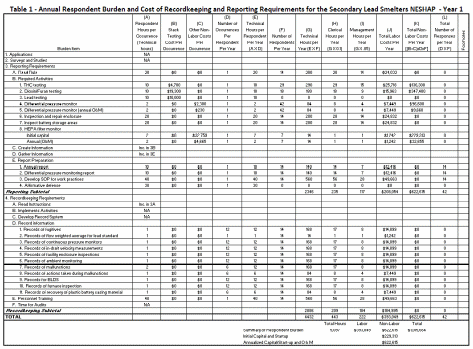
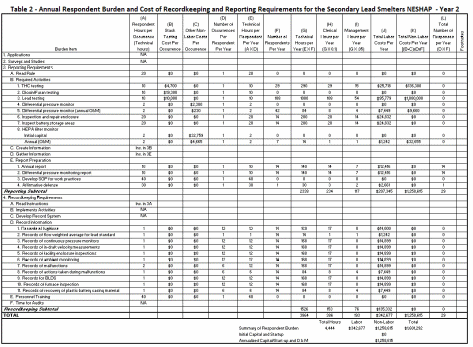
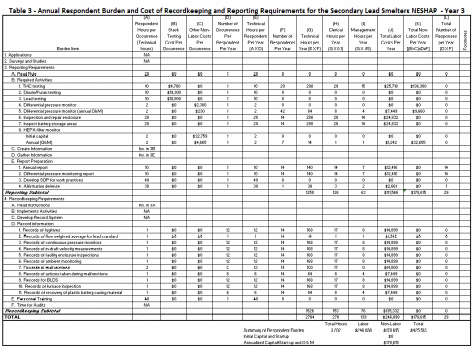

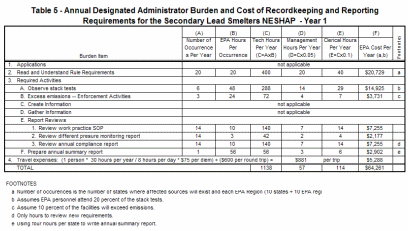
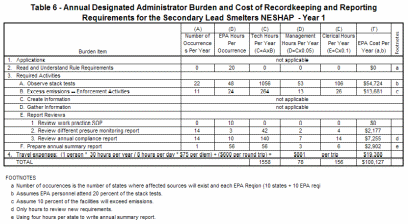
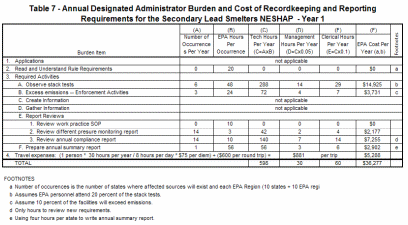

ATTACHMENT 2. INFORMATION REQUIREMENTS----AMENDMENTS TO SECONDARY LEAD PROCESSING NESHAP
Requirement |
Citation for existing sources |
Citation for new sources |
General Provisions citation |
Emission limits for vents |
§63.543 |
§63.543 |
|
Standards for Fugitive Emissions |
§63.545 |
§63.545 |
|
Monitoring |
§63.548 |
§63.548 |
N/A |
Notifications |
§63.549 |
§63.549 |
63.9 |
Recordkeeping and reporting requirements |
§63.550 |
§63.550 |
|
Reports of malfunctions that result in an exceedances of the standard for the purpose of affirmative defense |
§63.552 |
§63.552 |
|
Records |
§63.541 |
§63.541 |
63.10 |
Reports |
§63.541 |
§63.541 |
63.10 |
| File Type | application/vnd.openxmlformats-officedocument.wordprocessingml.document |
| File Title | SUPPORTING STATEMENT |
| Author | Marvin Branscome |
| File Modified | 0000-00-00 |
| File Created | 2021-02-01 |
© 2026 OMB.report | Privacy Policy